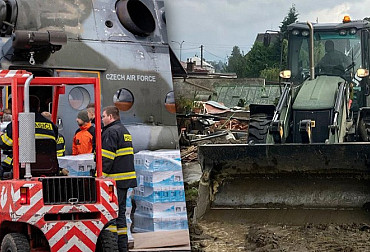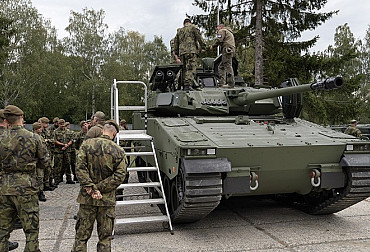Czechs and Slovaks from the Multinational Battle Group understand each other even without previous training
Approximately 250 Czech soldiers have been deployed in Slovakia in the NATO Multinational Battle Group since the beginning of April. Some of them are paratroopers from Chrudim, who this week completed their first live training with their Slovak colleagues in Leszto near Zvolen. According to the deputy commander of the 43rd Airborne Regiment, Lieutenant Colonel Ivo Zelinka, the training is designed to enable the soldiers to move from the deterrence phase to the defence phase.
The NATO Multinational Battle Group will have up to three thousand soldiers from the Czech Republic (lead country), Slovakia, Germany, the USA, the Netherlands and Slovenia. Troops from these countries are already in place and training, with Slovenian troops arriving in the coming weeks.
 Picture: Czechs and Slovaks from the International Battle Group | SkKySIO
Picture: Czechs and Slovaks from the International Battle Group | SkKySIO
The multinational unit is designed to conduct defensive ground operations with complementary air defence capabilities and is equipped with wheeled armoured vehicles.
The current training of the units in Slovakia is focused on synergistic activities of different units using heavy weapons, whether it is U.S. mortars versus Czech artillery guides or vice versa, according to the deputy commander of the Czech 43rd Airborne Regiment, Lt. Col. Ivo Zelinka. The units are also aligning in the command and control system of operations and practicing even the lowest tactics. "The training is managed in this way in an efficient way so that we can react quickly if we move from the phase of deterring the enemy to the phase of defence," he explains.
In addition to the Czech and Slovak paratroopers, special forces and reconnaissance units from our eastern neighbours have also been involved in the training of the so-called immediate reaction strike team, which is part of the battle group. The training centre in Leszto offers an excellent opportunity to train in built-up areas and buildings (FIBUA and CQB). The soldiers were tasked with capturing one of the buildings in the training village, so called clearing and securing it. They were inserted into the area by rappelling down a fastrope from a UH-60 Blackhawk helicopter and in LR 130 Cayman light assault vehicles.
 Picture: Czechs and Slovaks from the International Battle Group | SkKySIO
Picture: Czechs and Slovaks from the International Battle Group | SkKySIO
"The soldiers used what is known as mechanical and explosive breaching to enter the facility. They cleared the building of the enemy, incapacitated a person of interest, secured documents and communications equipment. All this using live ammunition. In the end, the main forces on Cayman vehicles withdrew, and combat support elements, including snipers and reconnaissance teams, moved along their own axis to then join their own units," Zelinka described one phase of the exercise.
He said the joint training was a successful demonstration of the interoperability of the Czech 43rd Airborne Regiment and the Slovak 52nd Airborne Battalion. "These units have never exercised together, but after a very short interoperability training we are capable of relatively complex actions, which shows common standards, either at the operational level of NATO standards or very similar tactical procedures. This is a very good stepping stone for future cooperation," Zelinka stressed.





















